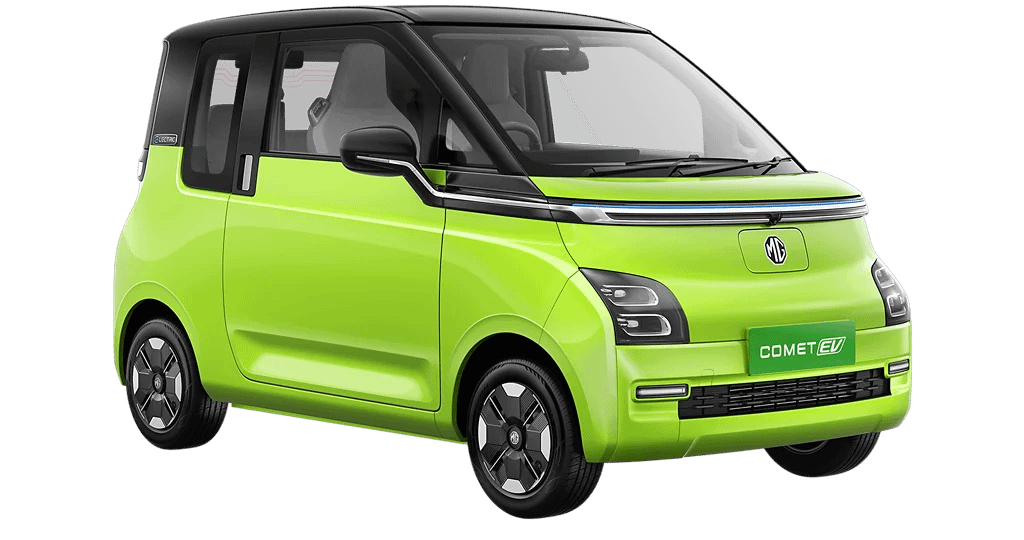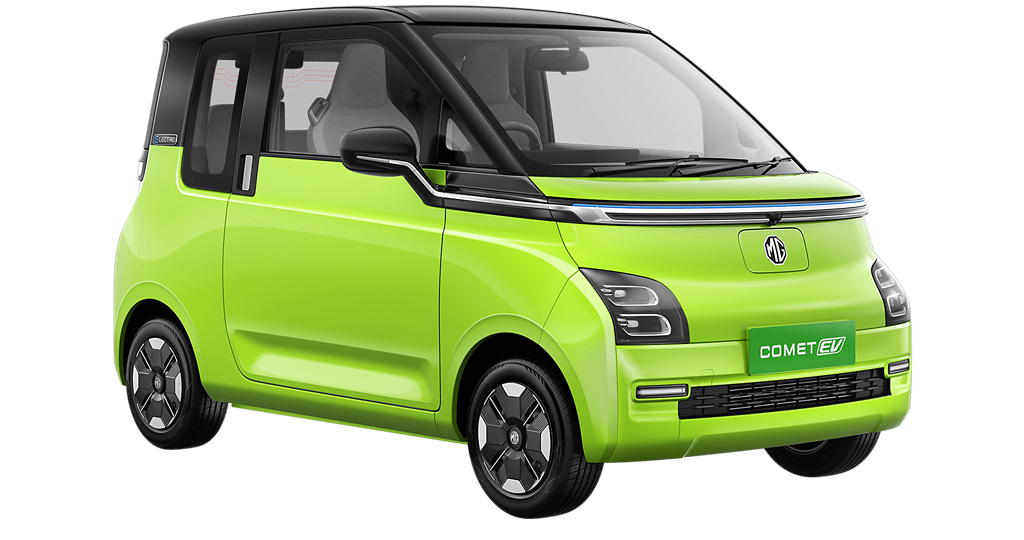Unveiling the MG Comet EV: A Compact Electric Car for 2023 and Beyond

Powering the rear wheels of the MG Comet EV is a permanent magnet synchronous motor that puts out 41 BHP and 110 Nm:

Before we get to the driving part, let’s get some basics right. There are 3 main components in an EV – the battery, the motor, and the controller/charger. The battery is what stores the energy and the motor is what uses that energy to move the car. The controller/charger converts the energy from the battery into a usable form to power the motor. In more technical terms, the power grid from your house or a charging station is usually an AC current. The lithium-ion battery can store electric energy in DC form. So while charging, there’s an AC/DC converter that will convert the power grid’s AC into DC and store it in your car’s battery. The DC fast chargers that you see usually have the AC/DC converter inbuilt, which is how they can charge your car’s battery faster. However, that option is not available on the MG Comet. You only have the option of 3.3 kW AC charging. In the case of the MG Comet, the motor is placed at the rear axle, the battery is in the middle and the controller sits at the front.
Step inside the Comet and don’t bother looking for a start/stop button. You won’t find one. Just press the brake pedal twice and the Comet is ready to drive. It’s that simple! And if you want to switch off the car, switch to N, pull the handbrake, step out, close the door, walk away, and lock the car. The car will switch off and lock itself. Super convenient! Back to where the car was ready to drive, switch to D mode and tap the accelerator to get moving. The Comet doesn’t have a creep function, so with a light foot on the accelerator, the car moves off the line smoothly. The build-up of speed is linear and without any jerks.
We got to drive around in the city of Delhi in different traffic conditions and this is where the Comet felt at home. With no gear shifts, no lag of any sort and no engine noise, the Comet felt quite comfortable and convenient to drive. The motor’s 41 BHP may seem less on paper, but when your average driving speed in the city is pretty low, the power on tap seems more than adequate. It’s not super quick off the line, but it builds speed faster than budget IC engine cars. You get a linear power delivery and the car is reasonably quick. You can easily keep up with the traffic and even execute quick overtakes when required. The compact size does mean that you might get bullied by bigger cars, but you can also squeeze through gaps with ease.
As mentioned earlier, the Comet is primarily a city car and not really meant for highways. Going over 80 km/h is something you should avoid. Remember that single-gear EVs lack punch at the top-end. The build-up of speed till 80 km/h is easy, but above that, the progress is slow. Also, given the dynamics of the car (more on this later), you won’t really want to drive this car at high speeds.
The Comet comes with 3 driving modes – Eco, Normal and Sport. Driving in Eco mode felt comfortable as the dulled throttle response made the car much smoother to drive. Also, in the Eco mode, it doesn’t feel devoid of power. You still can keep up with traffic and drive comfortably. In Normal mode, the throttle response is sharper and it’s a good mode to zip around the city. The Sport mode doesn’t really change things from normal mode by a big margin. There is a noticeable difference, but you’re not making huge gains here.
Range
In our short media test drive, we didn’t get time to calculate a guesstimate range figure. However, as is the case with all EVs, push the car hard and you will notice the range and battery percentage falling at a rapid pace. The ARAI-certified range of the Comet EV is 230 km. While speaking with some of the MG engineers, they claimed that in their internal testing, they achieved even up to 180 km range under normal driving conditions i.e. with the air-conditioning ON. MG claims that the prismatic structure of battery cells is what helps in extracting more range from this tiny LFP battery. With varying driving styles under different conditions, a 150-160 km driving range is safe to assume. We shall wait for ownership reviews to get a better idea though.
Charging
The MG Comet EV’s battery capacity is 17.3 kWh. It’s an LFP (lithium ferro-phosphate) type lithium-ion battery. With a 3.3 kW AC home charger, the battery can be charged from 10-80% in approximately 5 hours. For 0-100% charging, the time would be approximately 7 hours. This is the only charging option available with the Comet. It doesn’t support fast AC charging, nor does it support DC fast charging. So, at the end of the day, you will have to charge it at home itself. Faster charging options should’ve been made available.
Electrifying Performance:
At the heart of the MG Comet EV is a cutting-edge electric powertrain that promises an exhilarating driving experience. Boasting a powerful electric motor, the Comet accelerates swiftly and silently, delivering a seamless and responsive performance. With zero tailpipe emissions, the MG Comet EV contributes to a cleaner and greener future, aligning with the global shift towards sustainable transportation.
Striking Design:
Beyond its eco-friendly credentials, the MG Comet EV catches the eye with its contemporary and stylish design. From its aerodynamic profile to the carefully crafted interior, MG has prioritized aesthetics without compromising functionality. The sleek lines and futuristic elements not only enhance the vehicle’s visual appeal but also contribute to its overall efficiency.
Regenerative Braking
The MG Comet gets 3 levels of regenerative braking – Heavy, Normal and Light. They perform as their names suggest. At the highest level, the regeneration is quite strong and you will feel a jerk when you lift off the accelerator. I preferred having the regeneration in Normal mode as it is similar to the engine braking in IC engine cars.
Noise, Vibration & Harshness (NVH)
This is an area where EVs usually excel thanks to the lack of an engine, no gearshifts, and minimal mechanical parts. There are no jerks or vibrations either, but you do hear the motor whine when you floor the accelerator pedal. Tyre and wind noise also start to creep in when you are at speeds above 60 km/h.
Ride Comfort
The MG Comet has McPherson strut suspension at the front and multi-link coil suspension at the rear. No, this isn’t the sporty kind of multi-link suspension. It rides on 12-inch wheels that are shod with 145/70 section tyres. Our test car had Ceat EnergyDrive tyres which are EV-specific tyres with low rolling resistance. The recommended tyre pressure is 33 PSI at the front and 36 PSI at the rear.
Start driving and you will notice that the suspension is quite absorbent at low speeds. The suspension travel isn’t very long given that the size of the car is small, but small and medium-sized bumps are absorbed nicely. Big bumps and potholes do make themselves felt quite sharply in the cabin. Also, while driving in the city, you will feel that the short wheelbase of the car results in additional movement in the cabin. Overall though, the ride quality is comfortable for a city car. At higher speeds, you must be careful over expansion joints or random undulations as they can upset the balance of the car.
Handling & Dynamics
The Comet EV has been designed as a comfortable city car to be driven sedately. There’s no point in expecting enthusiastic handling from this hatchback. The tiny wheels and skinny tyres, high centre of gravity, soft suspension with limited travel and vague steering won’t really encourage you to push the car to its limit. You’re better off driving it like a point A to point B vehicle. Push the car hard into a corner and you will feel a bit of understeer. Keep the accelerator pinned into a corner and the rear steps out as well. All of this is scary and you wouldn’t want to push the car to that extent.
Steering
The electric power steering unit in the Comet is very user-friendly. It is super light at city speeds and easy to use. With a turning radius of barely 4.2 meters, you will rarely find yourself taking 3-point turns in this EV. While the steering weighs up as you gain speed, it still feels light at speeds above 60 km/h.
Braking
The Comet has disc brakes at the front and drum brakes at the rear. They perform well under most driving conditions and the car comes to a halt in a predictable manner. However, the tyres will play an important part in the long term as these are low-profile units. The pedal has a spongy feel to it. This feels weird at first, but you get used to it.



What is price of this car
The MG Comet EV has an ex-showroom price range of ₹7.00 Lakh to ₹9.84 Lakh. The on-road price in Chennai can vary based on the variant and can range from ₹8.68 Lakh to ₹10.21 Lakh.